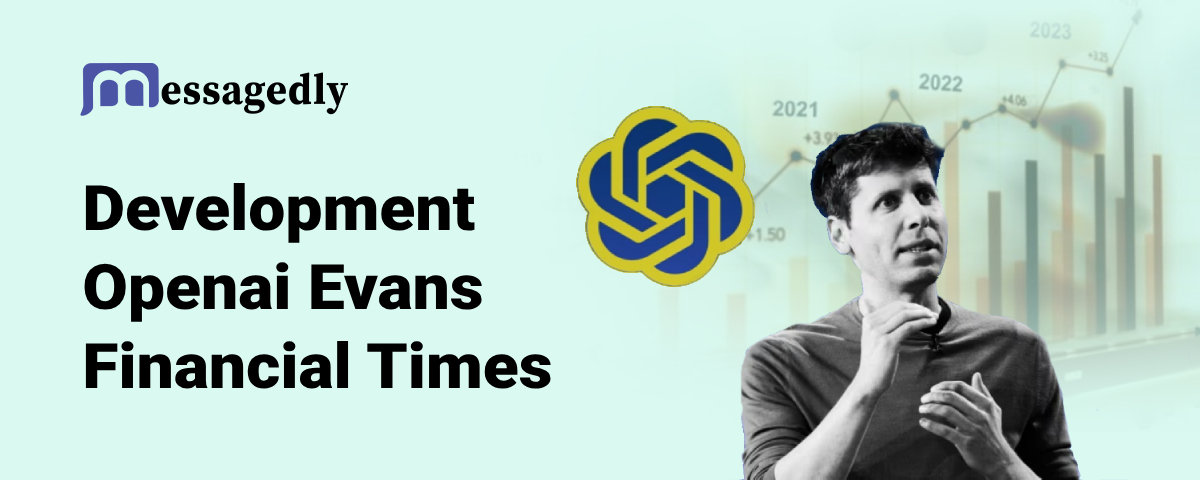
Development Openaievans Financial Times highlights AI’s future, showcasing innovation and industry transformation. In the rapidly developing world of artificial intelligence (AI), OpenAI stands out as a frontiersperson in developing cutting-edge technologies. Whether you believe it or not, sooner or later AI will be an alternative for lots of jobs that humans perform. Artificial intelligence can’t be overlooked, and a better understanding of this application will help us become part of the new face of humanity and tackle it in the right direction.
This article, “Development Openaievans Financial Times,” discusses the deep consequences that OpenAI’s advancements, particularly their EVANS model, have on the financial sector. In the era of complex decision-making and market analysis, the advancement of AI in financial services has done a lot. It has guided us toward becoming cost-efficient, streamlined and more accurate.
In the transforming era of AI, open AI models are contributing to the automation of essential financial chores, enhancing efficiency, and providing more informed decision-making.
Interested to know more about the Openaievans and their impact on financial times. This blog will help you explore the Development Openaievans Financial Times and its impact on industries like the Financial Times.
The Origins of OpenAI
In December 2015, OpenAI was founded by a group of tech visionaries, including Sam Altman and Elon Musk. Despite being such a short duration, it has accomplished quite a lot. OpenAi was started with the goal of promoting AI in a way that benefits everyone in the world. The team behind this includes the sharpest intellect in this field like Andrej Karpathy, Jessica Livingston, Peter Thiel, Ilya Sutskever and Greg Brockman.
With an endowment of $1 billion, the company was started by its founders and investors. The major aim of Open AI is to develop and direct artificial intelligence in such a way that it can benefit the whole of humanity. All the research and patents that are made by the company are planned to remain open to the public besides the cases where they can negatively affect the safety.
Approximately around 2 years later, OpenAi introduced the idea of Generative Pre-trained Transformers(GPTs). GPT is a machine-learning model that functions like a human brain and is trained on inputs. Later, Elon Musk left the company in February 2018 due to a potential conflict of interest with his work at Tesla, a company inspired by Nikola Tesla.
Evolution of OpenAI Over the Years
In the span of a year, OpenAI has experienced a tremendous evolution, transitioning from rule-based algorithms to in-depth learning models capable of doing complex tasks. OpenAI has been continuously testing the boundaries of what AI can achieve.
In the year 2018, the company published a research paper titled “Improving Language Understanding By Generative Pre-training”. That is what inspires the company to introduce the idea of Generative Pre-trained Transformers (GPTs). But what turns out to be a revolutionary move is the introduction of GPT-3 in the year 2020. This platform has opened a different path for artificial text generation. GPT-3 allows its users to develop various text content depending on the context and predicts statements according to given sentences.
The transformative power of GPT has influenced various sectors. The impact on the journalism of GPT has been particularly impressive. The ability to quickly generate, verify facts, and assist in research through GPT enables the generation of high-quality content efficiently.
Financial Times: A Pillar of Financial Journalism
In a world, where financial markets are interlinked with each other. And economies are deeply connected across borders, the role of publications like the Financial Times has become more crucial.
The Financial Times, a global business publication based in London, was founded in 1888. In the world of journalism, the Financial Times has unfailingly proven itself as the most trustworthy in the field. By offering readers the insight and analysis that they require to make informed decisions.
Across the year, the Financial Times has been the most admirable source of global financial news, shaping the perspectives of businesses, investors, policymakers, and everyday readers alike. In the revolving era of digital media, it has faced numerous challenges. Nevertheless, the Financial Times has shifted towards the digital-first strategy, leveraging data and technologies that are necessary to maintain its impact.
The Intersection of AI and Financial Journalism
The role of AI in journalism has been extended far beyond automation. In today’s world, AI tools are used to examine immense amounts of financial data, generate insights, and help write content based on precise frameworks. Additionally, the use of an Al image generator allows publications like the Financial Times to create custom visuals and infographics, enhancing the storytelling experience for readers. The use of AI tools offers benefits for productivity and innovation. AI helps publications like the Financial Times make sense of complex data, identify trends, and, most importantly, create customized content for readers. This is often achieved through LLM chaining, a method of linking multiple AI tasks together — such as data retrieval, sentiment analysis, and summarization — into a seamless pipeline.
Analysis of stock markets and financial trends is one of the noteworthy applications of AI in financial journalism. Algorithms can process market information instantaneously, giving journalists insights that might miss. This overall algorithm helps the Financial Times outpace the competition by offering accurate and timely information to its readers.
OpenAI’s Role in Enhancing Financial Times’ Digital Strategy
The integration of OpenAI models such as GPT, has been a difference maker in publications like Financial Times. This integration allows Financial Times to use AI tools for content creation, summarizing financial data and even preparing financial news reports based on the current market updates.
Apart from the Content creation, OpenAI also delivers publications like the Financial Times with AI-powered suggestions and insights regarding the reader’s tastes. Financial Times subscribers acquire personalized news feeds based on their interests and history through OpenAI, a machine learning algorithm.
Ethical Considerations in AI and Journalism
AI is becoming more familiar in financial journalism, and some are trying to find more ethical ways of using the technology. No doubt, AI brings a lot of benefits in the field of financial journalism. But it also raises significant ethical questions. AI consulting services can play a crucial role in addressing these, helping organizations define responsible AI frameworks and decide to what extent they should allow AI to take control and decision-making.
The usage of AI in journalism comes with a lot of pros and cons. It might be a helpful tool in content creation, finding data and minimizing workload. However, it could also breach journalistic, as AI models are oriented on existing data, which might contain ingrained biases. This information can directly impact the decisions related to financial markets and investment decisions. That’s why it is important to ensure transparency and accountability.
Financial Times’ Future with OpenAI
Looking at the emerging era of AI, it can be said that the partnership between OpenAI and journalism will be more likely to have significant evolution. OpenAI continues to influence how to simplify the process of writing, publishing and assisting journalists in writing content, reports and insights of data at faster rates.
With a frequent change in the taste of people, it is difficult to know about the emerging trends in the market. That’s where OpenAi stands out by providing AI tools that are capable of predicting analysis, real-time reporting and providing authentic financial prediction.
The Global Impact of OpenAI on Financial Reporting
The financial reporting industry has been a cornerstone of the global economy, shaping the decisions that businesses or individuals make regarding stock markets and financial institutions. Without a doubt, OpenAi is transforming the standard of financial reporting. Financial Reporting organizations all around the world are embracing AI tools for everything. For example, many organizations are using embedded analytics tools to integrate reporting in their apps and website.
From automating content writing to examining the international trends in the markets. The integration of OpenAI with Financial Times will clearly give a cutting edge in the world of the AI-driven journalism industry.
Challenges of AI Integration in Journalism
The ongoing evolution of artificial intelligence has definitely revolutionized multiple industries including Journalism. Integration of AI into journalism has various benefits, but there are certain areas where this application might be problematic. AI-generated content can have numerous imperfections due to a lack of contextualization.
Journalists have a responsibility to provide accurate and balanced reports but the problem appears when AI in journalism is the lack of ability to consider journal ethics. AI-based journalism tools might provide unreliable and biased information based on unintentional errors. Another big challenge that AI integration faces is the lack of human intuition.
Benefits of OpenAI in the Financial Sector
OpenAI brings a lot of value to the financial sector business. AI can transform every aspect of financial services. AI is the most crucial tool for improving data analytics and streamlining the reporting process in the field of the financial sector. OpenAI also helps in tracking user patterns. It tracks users’ data, habits and interactions with various websites and platforms to better understand interests.
For the fast-paced generation, relevant data can significantly increase the conversion rates.
The ability of AI to process a vast amount of data in seconds helps the financial sector to make informed decisions more faster and accurately. This same capability allows reporters in journalism to create in-depth and precise content.
However, it is not possible for AI to fully replace human journalism. But to produce high-quality and insightful content in journalism humans and AI need to work together.
The Future of AI-Driven Journalism
Looking at the AI-driven world, the opportunities for AI-driven journalism are effectively endless. We can accept more inventions in the content creation, data analysis and even engagement of the audience with the continuous improvement in AI.
However, it is not possible for AI to fully replace human journalism. But to produce high-quality and insightful content in journalism humans and AI need to work together.
Frequently Asked Questions (FAQs)
Q1. Can AI fully replace human journalists?
A. AI can assist you in research, creating content and organizing data. But cannot replace the human journalists who make the writing unique through their creativity and personalized touch.
Q2. How OpenAI EVANS is Revolutionizing Development Openaievans Financial Times?
A. OpenAI Evans has transformed journalism, by empowering publications like Financial Times with AI-generated content. Which overall enhances the accuracy and insights of the content making it easier for journalists.
Q3. What is the impact of AI on financial services?
A. Using AI in financial services has a huge impact on financial services as it brings new opportunities and benefits to financial institutions. The benefits that it provides are enhancement in productivity, cost-effectiveness and customization offered to clients.
Q4. What is the future of the Financial Times with AI integration?
A. The integration of AI is shaping an exciting future for the publication, The Financial Times. As it provides content personalization, automated reporting and real-time analysis.
Q5. How does AI improve financial reporting?
A. AI improves financial reporting by quickly analyzing complex data, determining trends, and automation which leads to making reports more accurate and faster.
Conclusion
In conclusion, the “Development Openaievans Financial Times” represents the relationship between Open AI and the Financial Times. OpenAI’s advancements, particularly the EVANS model, have reshaped journalism by driving automation and streamlining the content creation, research and data analysis.
The innovation of Open AI clearly demonstrates its tremendous potential to transform financial reporting, making it more accurate, reliable, personalized, and faster. As mentioned earlier in this article artificial intelligence has its own benefits but humans remain a crucial element in Journalism. In the end, a collaboration of human writers and AI can only predict the future of Journalism, assuring that readers receive accurate and reliable information.
Also Read: SharedSumo.com: The Ultimate Content Collaboration Platform for Teams


